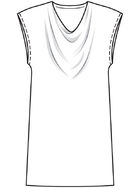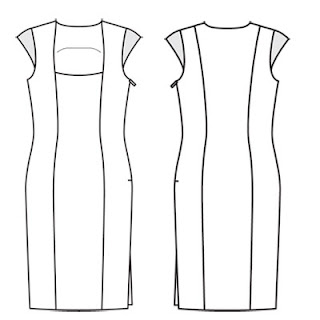This isn't the wowza item I would have liked to give you for the end of this year, but it's perfectly respectable as a "found" dress made from a forgotten remnant of wool mix in a pin-stripe and burgundy poly satin lining. I'm not sure the neckline is for me, as I don't have a formidable and flawless chestbone area, but for what's it worth, here is Burda's sheath from the July 2011 edition as discussed in a previous post. (Yes, it's that bright in the Swiss mountains in the winter! The gray cashmere cardigan is really not even necessary in the midday sun up here.)
This photo shows that weirdly, I've lost weight around the waist since I fitted this dress a few weeks ago. It's not actually wrinkled around the midriff—I am. I can either add a belt or take it in some more, as I'm planning to wear it at the annual Geneva Writer's Group Agents and Editors weekend in early February.
The cause of the weight loss may be the stress and exercise of entertaining whole hordes of incoming gangs of now-adult friends of my once-children. It was one thing to hand out crisps and cookies to a gaggle of little kids, but now it's a question of ten strapping Swiss men and gorgeous women at a table for dinner and breakfast at one go, and another, and another to come when the Cambridge graduate friends arrive from the UK.
We took a family walk yesterday in the "backyard" which is actually 80 sq. kilometers of cross-country ski trails. I feature my daughter so often in the dressmaking posts that I thought I'd share the two sons for a change as they relish their break from English weather.
This last is a sentimental shot to do with crafts: Notice the small folding screen in the back on the grand piano depicting the Three Magi in felt on a red background of corduroy? It was crafted by my late father as he coped with very radical surgery and followup from cancer in the early sixties, based on a project he found in one of my mother's issues of McCall's magazine. We treasure it for obvious reasons. The tree is hung with dozens of stuffed figurines based on the Nutcracker Suite from a OOP Vogue Craft pattern from the late 70's, another treasure we bring out every year and that took me truly decades to complete, doing one or two every post-Xmas week. I think there are a few shepherdesses still to do, but give me a break.
I don't think I've shown this room before, the sitting room with the fireplace, converted in the 1960's from the former winter shelter for the goats and cows. In the background you see the hall leading to the kitchen and its bookshelves, which is followed by a dining room and then a library. It's a pretty big old farmhouse, built in 1789, which grew and grew. It usually takes houseguest a full day or two to figure it out, as it's built into a hill and there is a back door on an upper floor which leads onto the backyard, three front doors, two back entrances, and six bedrooms, two of them converted to offices.
Why six? Because when you make it yourself, you add one more essential element...your own vision.
Sunday 30 December 2012
Monday 24 December 2012
Between Aug, 2011 and Jan 2013, nothing changed?
Funny to watch how some designs kind of "melt down" from the designer version to the bare basics for beginning sewists: The fashionistas all made this Donna Karan knit dress, with its lovely fitted three-piece back, right off the bat, when it appeared some years ago:
Burda made it a one-day project by eliminating the three-piece back half.
 And Burda now says, you can get something like that cowlneck dress in ONE HOUR by sewing this version and adding a belt to pull it in.
And Burda now says, you can get something like that cowlneck dress in ONE HOUR by sewing this version and adding a belt to pull it in.
Burda made it a one-day project by eliminating the three-piece back half.
 And Burda now says, you can get something like that cowlneck dress in ONE HOUR by sewing this version and adding a belt to pull it in.
And Burda now says, you can get something like that cowlneck dress in ONE HOUR by sewing this version and adding a belt to pull it in.
Hmmm...
Monday 17 December 2012
The Burda "Classic" Magazine issued last month
Last month, Burda issued an out-of-series special, called The Classics, based very loosely on a Chanel look, and I nabbed it with high hopes. Unfortunately, I find the styles just a tad clunky and boxy, as if they took everything I hoped for and stripped the designs down one notch too far. It's not labelled "Easy," so it's not part of that series, but still, the items look under-designed. Check out the whole magazine, by clicking here: Burda Classic Collection
This issue would be a great start for people who like to draft their own Frankenpatterns, need a work wardrobe that doesn't scream 'trend-slave,' or for a young sewist who wants to build her pattern library with some fundamentals she could play with.
But some of the styling relies too much on judicious accessorizing.
As I was just blogging about the option in the Style archives for 'shovel-neck' sheaths, (and I ignored many more nice designs for Plus sewists,) here's the Classic offering, which gives us a fitting seam, Empire-style, under the bosom and two darts, as well as three sleeve options. As you can see, it is a classic design, lacking the little edge that brings these dresses closer to the Galaxy look.
This issue would be a great start for people who like to draft their own Frankenpatterns, need a work wardrobe that doesn't scream 'trend-slave,' or for a young sewist who wants to build her pattern library with some fundamentals she could play with.
But some of the styling relies too much on judicious accessorizing.
As I was just blogging about the option in the Style archives for 'shovel-neck' sheaths, (and I ignored many more nice designs for Plus sewists,) here's the Classic offering, which gives us a fitting seam, Empire-style, under the bosom and two darts, as well as three sleeve options. As you can see, it is a classic design, lacking the little edge that brings these dresses closer to the Galaxy look.
Monday 10 December 2012
A Tale of Two Dresses, Burda July, 2011
A bit of sewing was very relaxing over the last two weekends.
I've finally finished the red knit cowl-necked dress, (without a zipper, it's as simple to sew as a T-shirt) and will blog about it once I get up a photo (when it stops snowing!)
Meanwhile, I had a remnant of pin-striped wool/mix of only just over one metre (150cm wide) that I thought would make a good pencil skirt long ago. But it's been sitting alone in my sewing box (I don't really keep a stash) for two years-plus. I finally decided to take it out and use it.
I realized that a pencil skirt just wasn't enough motivation for me. Then, I thought of my daughter's "shovel-neck" sheath dresses, made twice; once in underlined lace and the other in a high-tech pleather and lined. Both were hits with her, but were so short that, of course, I could have made either version in a metre or less.
Could I squeeze a sheath for a grown-up out of so little fabric?
I looked at two designs, both from Burda. Although they are very similar, and both are designs that offer ample seaming for a nice fit, notice that the pieces of the second front give you more leeway in squeezing the most out of a short length of fabric than the awkwardly-shaped front of the first dress cut on the fold. I think I would have preferred the more generous sleeve of the first over the second, but I only noticed this too late. (I didn't sew the sleeves for the daughter's two dresses.)
This is one of the reasons I like the Burda Style magazines. People complain that they repeat themselves, but in fact, the Burda people tweak and vary hot designs to give you variations to suit your materials and desired "feel." I'm going to blog in my next post about a third shovel-neck sheath offered in the Burda Classic Collection magazine of November.
Here are the technical designs for the pattern used for daughter's sheaths, model 115 from October 09, and below that, the model from July 2011 I settled on, as photographed above, for the pin-striped remnant dress. I think of both as the sewist's quickie take on a fancy Galaxy dress, so popular years ago.
I made a couple of simple changes to this dress. First I added a burgundy satin lining, (also bought as a cheap remnant of one metre) underneath the inner front facing and substituting for the upper back facing. I omitted the interfacing on the sleeves as I didn't want wings, just sleeves, and as I had three layers rather than two at the neckline, didn't interface that either.
Most important, I wanted more pieces (and more flexibility) for an economical cutting layout. So I inserted the zipper into the middle of the center back, adding a seam where otherwise I would have been "cutting on the fold."
I used Nancy's technique for sewing the lining directly onto a sheath dress, stitching the neckline to the facing+lining and then sewing the raw edges of the outer sleeves along with the lower sleeve opening in one go, as if the sleeves were simply extensions on a sleeveless dress. I'll confess my corners on the dress neckline were a bit wonky, as it was difficult to align the dress seaming to a facing that had no seaming. (Note that to squeeze the facing out of my metre of fabric, I couldn't get it up to the fold. So I added a center seam. Next time, I'd just cut a lining in the color of the outer fabric with the same seaming as the dress pieces and discard the facing piece altogether.
I also shifted the walking vent to my new center back, from the side vent shown above.
I always prefer a back zipper construction to a side zipper placement because sewing the side seams absolutely last before hemming means that you can pop on the dress at the end of construction and simply mark chalk along where the side seams will give you a glove-like fit. (If the zipper were in place on one side, you wouldn't have that kind of symmetrical fitting flexibility.)
As I say, photos of the two finished dresses to come.
Subscribe to:
Posts (Atom)














